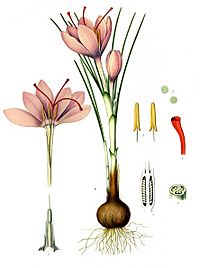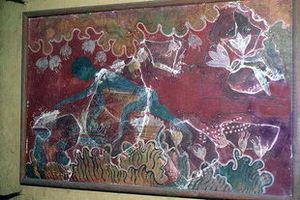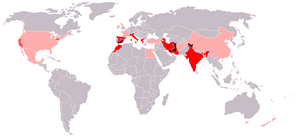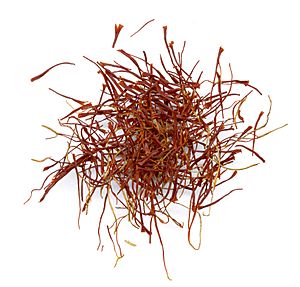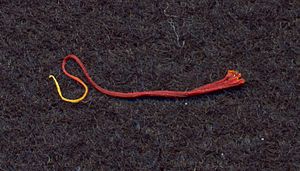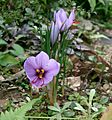Saffron facts for kids
Quick facts for kids Saffron crocus |
|
|---|---|
 |
|
| A saffron crocus flower with red stigma. | |
| Scientific classification | |
| Kingdom: | |
| Division: | |
| Class: | |
| Order: | |
| Family: | |
| Subfamily: |
Crocoideae
|
| Genus: | |
| Species: |
C. sativus
|
| Binomial name | |
| Crocus sativus |
|
Saffron is a special spice that comes from the red parts of a flower called the saffron plant. These red parts are called stigmas. People use saffron in cooking to add seasoning and to make food a beautiful golden colour.
Saffron originally comes from Southwest Asia. It has been the most expensive spice in the world for a very long time.
Saffron has a slightly bitter taste and smells a bit like hay. This unique smell comes from chemicals called picrocrocin and safranal. Saffron also has a natural dye called crocin, which gives food its rich golden colour. You can find saffron in many dishes around the world. It is also used in medicine.
The word saffron comes from an old French word, safran, from the 12th century. This word then came from the Latin word safranum. Safranum is also related to the Italian word zafferano and the Spanish word azafrán. The Latin word Safranum itself comes from the Arabic word DIN (أَصْفَر), which means "yellow".
Contents
About the Saffron Plant
| Saffron crocus parts | |
| → Stamens (male parts). | |
| → Corolla (flower petals). | |
| → Corm (underground bulb). | |
The saffron plant, also known as saffron crocus (C. sativus), is a perennial plant. This means it grows back every year. It flowers in the autumn.
This plant does not grow in the wild anymore. It is a special type of plant that humans have changed over time. It came from a plant called Crocus cartwrightianus, which is thought to have come from Crete. Farmers chose plants with longer stigmas, and over time, this led to the saffron crocus we know today.
The saffron crocus's purple flowers do not make useful seeds. This means the plant cannot reproduce on its own. Humans have to help it grow. Farmers dig up the corms, which are like underground bulbs. They break them apart and plant them again. A corm only lives for one season. It makes up to ten "cormlets" that will grow into new plants. These corms are small brown balls, about 4.5 centimetres (1.8 in) wide.
After a hot summer rest period called "aestivation", narrow green leaves start to grow from the ground. These leaves can be up to 40 cm (16 in) long. There are usually five to eleven leaves. In autumn, purple buds appear. In October, when most other plants have finished flowering, the saffron plant grows its bright purple flowers. The plant is usually less than 30 cm (12 in) tall when it flowers. Inside each flower, there are three red parts called "stigmas". These stigmas are between 25 and 30 mm long. These are the parts that become the saffron spice.
How Saffron is Grown
| Saffron flower amounts[*] from smaller farms | |
| Country | Amount (kg/ha) |
| Spain | 6–29 |
| Italy | 10–16 |
| Greece | 4–7 |
| India | 2–7 |
| Morocco | 2.0–2.5 |
| Source: Deo 2003, p. 3 | |
| [*]–Amounts show flower weight, not how much dry saffron is made. | |
The saffron crocus grows best in places with hot, dry summer winds, like the Mediterranean region. However, it can survive cold temperatures, even down to −10 °C (14.0 °F), and short periods of snow.
Saffron plants need the right amount of rain at the right time. They need a lot of rain in the spring and not much in the summer. Rain just before the flowers appear helps the plant make more saffron. Too much rain or cold weather during flowering can cause diseases. This means less saffron.
Other things that can harm saffron plants include:
- Long periods of damp or hot weather.
- Animals like rabbits, rats, and birds digging near the plants.
- Parasites like roundworms.
- Fungus and corm rot.
Saffron plants grow best in strong, direct sunlight. Farmers often plant them on hillsides that face the sun. In the Northern Hemisphere, planting usually happens in June. The corms are planted about 7–15 cm deep.
Farmers have found that planting corms 15 centimetres (5.9 in) deep and 2–3 cm apart in rows makes more saffron threads. If they plant them 8–10 cm deep, they get more flowers and corms. Saffron crocuses grow best in loose, moist, and well-drained clay soils with lots of organic material. They are often planted in raised beds to help water drain away. Farmers often add 20–30 tonnes of manure per hectare to the soil before planting.
The buds start to grow in early autumn, and the plants begin to flower in mid-autumn. Picking the flowers must be done quickly. They open at dawn but curl up and die during the day. Saffron flowers only last for one or two weeks.
To get about 1 g of dry saffron threads, a farmer needs to pick about 150 flowers. To make 12 g of dried saffron, it takes about 1 kg of fresh flowers. This means one fresh flower makes about 0.03 g of fresh saffron, or 0.007 g of dried saffron.
Saffron's Long History
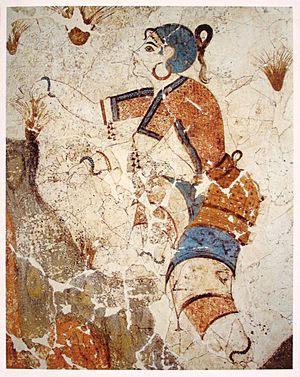
People have been growing saffron for over 3,000 years. The saffron crocus we have today came from a wild plant called Crocus cartwrightianus. Early humans started choosing wild plants that had long red stigmas. Over time, this led to the special C. sativus plant during the late Bronze Age in Crete.
Experts believe the first time saffron was written about was in a 7th century BC book from Assyria. This book was about botany (the study of plants). There is also proof that saffron was used to treat about 90 different illnesses over the past 4,000 years.
Saffron in the Mediterranean
The Minoans had pictures of saffron in their palaces as far back as 1500–1600 BC. These pictures showed how saffron could be used as a medicine. Later, Greek stories told of sea trips to Cilicia, where people hoped to find the world's most valuable saffron. Another story says that a person named Crocus was turned into the first saffron crocus flower.
Ancient people around the Mediterranean Sea used saffron in many ways. Perfume makers in Egypt, doctors in Gaza, and people in Rhodes used it. Greek women used saffron in their perfumes, creams, and even in mascara. They also used it in offerings to their gods and for medical treatments.
In ancient Egypt, Cleopatra used saffron in her baths because it made her feel good. Egyptian healers also used saffron to treat many stomach problems. Saffron was also used to dye fabrics in cities like Sidon and Tyre.
The Romans loved saffron so much that when they moved to southern Gaul, they took their saffron plants with them. They grew a lot of saffron there until the Roman Empire fell. Some people think saffron came back to France later with the Moors in the 8th century AD, or with the Avignon papacy in the 14th century AD.
Saffron in Asia
Paints made from saffron were used for drawing 50,000 years ago in the country we now call Iraq. Later, the Sumerians used wild saffron in their medicines and magic drinks. Traders carried saffron over long distances before 2000 BC.
Ancient Persians were growing their own type of saffron by 10th century BC. They grew it in places like Derbena, Isfahan, and Khorasan. Sometimes, saffron threads were woven into clothes. They were also given to gods, and used in dyes, perfumes, medicines, and body washes. People even put saffron threads on their beds and mixed them into hot tea to help with sad feelings.
During his trips in Asia, Alexander the Great used Persian saffron in his tea, rice, and baths to help heal his battle wounds. Alexander's soldiers copied him and brought the idea of saffron baths back to Greece.
No one is sure how saffron arrived in South Asia. Stories from Kashmir and China say it arrived between 900 and 2500 years ago. Historians looking at old Persian records think it arrived before 500 BC. It might have been brought by Persians who planted saffron corms in new gardens, or by a Persian invasion of Kashmir. Then, people from Phoenicia sold Kashmiri saffron as a dye and a medicine for sadness. From there, saffron spread throughout South Asia for food and dyes. For example, Buddhist monks in India started wearing saffron-coloured robes after the Buddha Siddhartha Gautama died. However, these robes were often dyed with cheaper turmeric or jackfruit, not costly saffron.
Some historians believe saffron first came to China with Mongol invaders from Persia. But saffron is also mentioned in old Chinese medical books. One book, Shennong Bencaojing, from 200–300 BC, talks about 252 plant-based medicines. Around 3rd century AD, the Chinese said saffron came from Kashmir. For example, Wan Zhen, a Chinese medical expert, wrote that saffron grows in Kashmir, where people grow it mainly to offer it to the Buddha. Wan also noted how saffron was used then: "The [saffron crocus] flower withers after a few days, and then the saffron is obtained. It is valued for its uniform yellow colour. It can be used to add flavour to wine."
Saffron in Europe
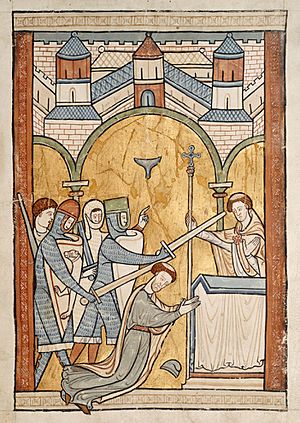
After the Roman Empire fell, saffron growing in Europe greatly decreased. Saffron was brought back when the Islamic civilization "Al-Andalus" spread to Spain, France, and Italy.
During the Black Death in the 14th century, there was a huge need for saffron-based medicines. Many ships from Venice and Genoa had to bring saffron from southern lands like Rhodes. Once, noblemen stole a shipment of saffron, which started a 14-week "Saffron War." This conflict and the fear of saffron piracy led to a lot of saffron being grown in Basel, which became rich. Growing and trading saffron then spread to Nuremberg.
Soon after, saffron growing spread throughout England, especially in Norfolk and Suffolk. The town of Saffron Walden in Essex was even named after its new special crop. It became England's main saffron growing and trading center. However, new and exciting spices like chocolate, coffee, tea, and vanilla came from other parts of the world. This made Europeans use and grow less saffron. Only in southern France, Italy, and Spain did people continue to grow a lot of saffron.
Europeans brought saffron to the Americas. Immigrants from the Schwenkfelder Church left Europe with saffron corms in a trunk. Many of these people had grown saffron widely in Europe. By 1730, the Pennsylvania Dutch were growing saffron all over eastern Pennsylvania. Spanish colonies in the Caribbean bought a lot of this new American saffron. The high demand meant that saffron's price in Philadelphia was as high as gold.
The trade with the Caribbean stopped after the War of 1812, when many ships carrying saffron were destroyed. But the Pennsylvania Dutch kept growing smaller amounts of saffron for local trade. They used it in their cakes, noodles, and chicken or trout dishes. American saffron growing continued into modern times, mainly in Lancaster County, Pennsylvania.
Saffron Today: Trade and Uses

Saffron's smell is often described as being like metallic honey with hints of grass or hay. Its taste is also said to be hay-like and a bit bitter. Saffron gives food a light yellow-orange colour.
Saffron is used a lot in Iranian (Persian), Arab, Central Asian, European, Indian, Turkish, Moroccan, and Cornish cooking. You can also find saffron in sweets and drinks.
Common things used instead of saffron include safflower (sometimes called "Portuguese saffron") and turmeric. Saffron has been used as a traditional medicine for a very long time. Modern science has found that it might help fight cancer, prevent harmful changes in cells, boost the immune system, and act like an antioxidant. Saffron has also been used to dye fabrics, especially in China and India, and in making perfumes.
| Where saffron is grown in the world | |
|
|
|
| – Main growing areas. | |
| – Main producing countries. | |
| – Smaller growing areas. | |
| – Smaller producing countries. | |
| – Main places where saffron is traded (now). | |
| – Main places where saffron was traded (in the past). | |
Most saffron is grown in a long strip of land from the Mediterranean in the west to Kashmir in the east. About 300 tonnes of saffron are produced worldwide each year. Iran produces the most saffron, making over 94 percent of the world's supply. Other countries that produce saffron include Spain, India, Greece, Azerbaijan, Morocco, and Italy.
To get one pound (0.45 kg) of dry saffron, you need 50,000–75,000 flowers. These flowers would cover an area about the size of a football field. It takes about forty hours of work to pick 150,000 flowers. After picking, the stigmas are dried quickly and stored in airtight containers.
Saffron prices can range from US$500 to US$5,000 per pound (US$1100–US$11,000 per kilogram). In Western countries, the average price is about $1,000 per pound. One pound of saffron has between 70,000 and 200,000 threads. Good quality saffron is bright red, slightly moist, flexible, recently harvested, and has no broken pieces.
Types of Saffron
There are several types of saffron grown around the world. Spanish types, like 'Spanish Superior' and 'Creme', usually have a milder colour, flavour, and smell. They are graded by government rules. Italian types are a bit stronger than Spanish ones. The strongest types usually come from Iran.
It can be hard for people in Western countries to get saffron from India. India has stopped exporting its best saffron. Besides these, there are also special small crops from New Zealand, France, Switzerland, England, the United States, and other countries. Some of these are grown organically. In the U.S., Pennsylvania Dutch saffron is known for its earthy taste and is sold in small amounts.
Some types of saffron are considered "premium" quality. The "Aquila" saffron (zafferano dell'Aquila) from Italy is known for its high amounts of safranal and crocin, its unique shape, strong smell, and intense colour. It is grown in a small area in Italy's Abruzzo region. It was first brought to Italy by a monk from Spain.
However, the biggest saffron farm in Italy, both in quality and amount, is in San Gavino Monreale, Sardinia. Saffron there has very high amounts of crocin, picrocrocin, and safranal. Another top type is the Kashmiri "Mongra" or "Lacha" saffron (Crocus sativus 'Cashmirianus'). This one is very hard to buy. Repeated dry weather, diseases, and bad harvests in Kashmir, along with India's export ban, make its prices very high. Kashmiri saffron is known for its very dark red-purple colour, which is one of the darkest in the world. This colour shows its strong flavour, smell, and ability to colour food.
Saffron Quality Grades
| Minimum saffron colour grades (ISO 3632) |
|
|---|---|
| ISO Grade (category) |
Crocin-specific absorbance (  ) score ) score(at λ=440 nm) |
| I | > 190 |
| II | 150–190 |
| III | 110–150 |
| IV | 80–110 |
| Source: Tarvand 2005b | |
Saffron is graded by its quality based on lab tests. These tests measure things like the amount of crocin (for colour), picrocrocin (for taste), and safranal (for smell). They also check for other things, like how much flower waste or dirt is in the saffron.
The International Organization for Standardization (ISO) has set up a common way to grade saffron. This is called ISO 3632. It has four grades for colour strength: IV (the lowest), III, II, and I (the best quality). Saffron samples are given a grade based on how much crocin they have. This is found by measuring how much light the saffron absorbs. A higher number means more crocin and a stronger colour.
| Spanish saffron grades |
|
|---|---|
| Grade | ISO score |
| Coupe | > 190 |
| La Mancha | 180–190 |
| Río | 150–180 |
| Standard | 145–150 |
| Sierra | < 110 |
| Source: Tarvand 2005b | |
For saffron, this light absorption is measured at a specific wavelength of 440 nm. Higher absorption at this wavelength means there is more crocin, so the colour is stronger. These measurements are done in special labs around the world. The best saffron samples, which are the most red-maroon tips of the stigmas, can get scores over 250. The market prices for saffron usually follow these ISO scores.
However, many growers, traders, and buyers don't just rely on these lab numbers. They prefer to test saffron by tasting it, smelling it, checking how flexible it is, and looking at other features. This is similar to how wine tasters work.
Even with these ways to check quality, saffron has often been mixed with other things, especially the cheaper types. This problem has been happening for a long time. In the Middle Ages in Europe, people who sold fake saffron could even be put to death.
Common ways to fake saffron include mixing in things like beetroot, pomegranate fibers, red-dyed silk threads, or the yellow parts of the saffron flower that have no taste or smell. Sometimes, saffron threads are covered with sticky things like honey or vegetable oil. Powdered saffron is even easier to fake. People might mix in turmeric, paprika, or other powders. Faking saffron can also mean selling mixes of different saffron grades but labeling them as pure, high-grade saffron. For example, in India, expensive Kashmiri saffron is often mixed with cheaper Iranian saffron. These mixes are then sold as pure Kashmiri saffron, which has caused Kashmiri farmers to lose a lot of money.
Gallery
-
Saffron crocuses flowering in a garden in Osaka Prefecture (大阪府), Kansai, Honshū, Japan
Images for kids
-
Saffron harvest, Torbat-e Heydarieh, Razavi Khorasan Province, Iran
-
Kashmiri saffron package
-
Saffron market, Iran
See also
 In Spanish: Flor del azafrán para niños
In Spanish: Flor del azafrán para niños


